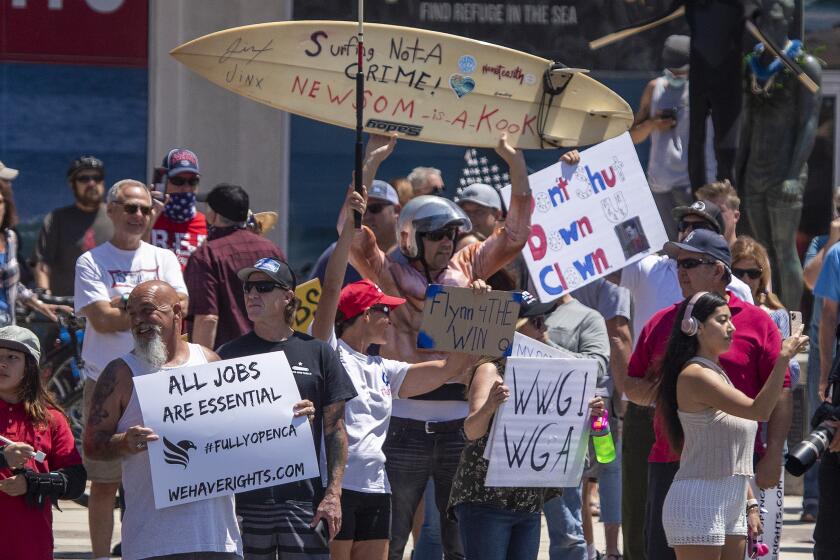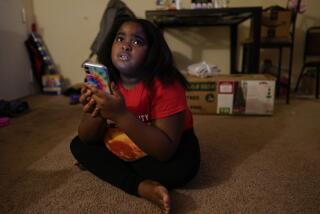What’s the link between the coronavirus and the Kawasaki-like disease MIS-C?
- Share via
One of the few silver linings of the novel coronavirus is that it mostly spares kids.
Or so we thought.
Children can become infected with the virus that causes COVID-19, but kids younger than 18 generally have fewer and less severe symptoms than adults, and many experience no symptoms at all according to the Centers for Disease Control and Prevention.
Less than 2% of confirmed cases have been diagnosed in children, and a report this week in the Journal of the American Medical Assn. suggests they may be less susceptible than adults because the cells in their nasal cavities produce fewer of the receptors that the coronavirus needs to begin its assault.
However, in the past few weeks doctors in the U.S. and Europe have discovered that among a small percentage of kids, the coronavirus can trigger a rare but serious inflammatory response up to three weeks after the initial viral infection is over. Health officials are calling it multi-system inflammatory syndrome in children, or MIS-C.
Children who develop MIS-C experience a range of symptoms that can include a high fever that persists for four or five days, rash, red eyes, red lips or tongue, red or swollen hands or feet, low blood pressure, unusual abdominal pain and persistent diarrhea.
If your child is experiencing any of these symptoms, call a doctor immediately.
“What we are learning is that some of these children are getting very ill rapidly,” said Dr. Jackie Szmuszkovicz, a pediatric cardiologist at Children’s Hospital of Los Angeles. “I want to encourage parents that if they are concerned about their child they contact their pediatrician and not delay care.”
While MIS-C is a serious disease that generally requires ICU care, treatments have mostly been successful.
And to reiterate: MIS-C is a very infrequent complication of COVID-19.
“Not everyone who gets COVID gets it,” said Dr. Karin Nielsen, a pediatric infectious disease specialist at UCLA. “Even in New York, which had a very large portion of the population becoming infected with coronavirus, MIS-C was not overwhelming.”
Kids with MIS-C can have some of the same symptoms of those suffering from Kawasaki disease, a rare inflammatory disease that affects about 5,500 children in the United States a year. Researchers now believe that some children diagnosed with Kawasaki disease between January and May might have actually had MIS-C instead.
There is no diagnostic test for Kawasaki disease, but its symptoms also include high fever, rash and swelling of the hands and feet. It can also cause inflammation of the walls of arteries, which can result in coronary artery enlargement, or aneurysms.
You’ve stayed at home long enough and want to socialize with your friends. Here’s how you can gather without putting your health -- or theirs -- in jeopardy.
In some ways, the delayed inflammatory response seen in kids with MIS-C mirrors what happens in adults who become acutely ill with COVID-19.
“Adults don’t usually get acutely sick in the first week of illness — usually they get a little better and then get really sick in the third week,” Nielsen said.
She noted that for adults this severe inflammation shows up primarily in the lungs, while in kids it seems to be more system-wide.
“It’s not exactly the same, but both seem to be related to the dysregulated immune response,” she said.
MIS-C is a new disease and doctors are learning more about it every day. Szmuszkovicz and Nielsen spoke to the Los Angeles Times about what researchers know so far, why medical professionals only became aware of it recently, and what they hope to learn about it in the coming weeks and months.
How was MIS-C first discovered?
Nielsen: It was first noticed in the United Kingdom, about a month after the big surge in COVID disease there. Doctors noticed a larger number of Kawasaki disease-like cases in children, as well as kids who had symptoms of toxic shock syndrome.
As the epidemic progressed, there was another large caseload of children in New York City who were showing these symptoms as well. As people started looking at this more closely, it became evident it wasn’t typical Kawasaki disease. That’s when this condition became recognized as a separate entity called multi-system inflammatory syndrome in children.
Szmuszkovicz: At Children’s Hospital LA we had an unusual uptick in the number of cases of a syndrome that appeared very similar to Kawasaki disease in the month of April. We had nine patients in April, and usually we will have none or maybe two.
Then we heard about patients in the U.K. and New York — some looked like they had Kawasaki and some were more on the spectrum of shock, or even toxic shock syndrome. It seemed there was an inflammatory process going on that might be potentially associated with COVID-19.
How is MIS-C different from Kawasaki disease?
Szmuszkovicz: What we are seeing is a real range in the symptoms of MIS-C disease. In some patients the inflammation looks more like Kawasaki disease; on the other end of the spectrum it looks more like a shock patient.
We are also learning that some of the MIS-C children are getting very ill rapidly, which is very unusual in Kawasaki disease.
Stunning visualizations show what the novel coronavirus, SARS-CoV-2, looks like at an atomic level of detail.
Nielsen: Kawasaki disease is an inflammatory illness of the blood vessels usually seen in children under the age of 5 and as young as 3 to 6 months. But after the age of 10 or 11, it is very rare. MIS-C can occur in adolescents, but the mean age has been around 8 years.
Why did it take medical professionals so long to notice MIS-C?
Szmuszkovicz: It is not unusual for us to have more cases of Kawasaki disease in the winter months, so nothing seemed different, even through March. But April was unusual, and that’s when we started saying something is different.
We’ve been testing our patients for acute COVID-19 disease, and none of them had that. I think it was only recently that we realized that the virus might be a trigger for the inflammatory response, and that was the reason we were seeing an uptick in cases. Now we are going back to test all Kawasaki disease patients from Jan. 1 for antibodies for the coronavirus.
Nielsen: We haven’t seen any publications from China on this syndrome; it was first described in the U.K. Also, there is a one-month lag behind peak COVID infections and the development of these cases in these children. That’s what we are seeing in N.Y. — the MIS-C cases began to surge four weeks after the big surge of COVID cases there.
Also, this condition is rare. It’s not like every child who has COVID has this condition. But because you have a very large number of cases, the denominator is so huge that you are going to see the rare cases more.
How do you treat it?
Nielsen: The treatment for this has been ICU supportive care. Most centers are treating it like they would Kawasaki disease. Kids are given a high dose of intravenous immunoglobulin that controls for the dysregulated immune response. If they don’t improve, some centers are giving a second dose. They are also given aspirin as an anti-inflammatory agent. Some centers will also treat with steroids and cytokine blockers.
Szmuszkovicz: Our treatment is focused on anti-inflammatory therapy and preventing clots.
It includes intravenous immunoglobulin, and we also use anticoagulation and antiplatelet agents to prevent clotting problems. In some patients we are using steroids, in others we are using immune system modulators.
Have treatments been effective?
Szmuszkovicz: Three of the four antibody-positive patients we’ve seen are all at home and doing well. The fourth patient was our one patient on the shock end of the spectrum and was quite ill. Thankfully, I can let you know that she is no longer in the intensive care unit and was able to move out to the regular floor. She is doing much better than expected.
Yes, there are significant health risks associated with lockdown. But returning to normal life too soon and rushing herd immunity would be even worse.
Nielsen: If children go to the ICU the vast majority of them will survive. I just listened to a CDC presentation about this, and in one center in New York, all children treated for this had survived and recovered.
There have been two or three cases of death recorded related to this. It’s a serious condition, but children are mostly surviving it if they get the adequate care they need.
Are some children at higher risk of getting MIS-C than others?
Nielsen: Not that we know. Kawasaki disease is more common in patients of Asian heritage, however that does not seem to be the case with MIS-C.
Szmuszkovicz: That’s the big question. We don’t know the cause of Kawasaki disease. We think there is an antigen trigger that affects genetically susceptible people. Just over the last few decades, there has been exhaustive research testing different infections that might be that trigger.
Now it seems that SARS-CoV-2 [the virus that causes COVID-19] may be one of the various triggers for symptoms that look like Kawasaki in a genetically susceptible host. We are working with centers across the world to collect the data on these kids and share that data to find out if there is a predisposition in certain ethnicities, and what the age range is going to be.
What do you hope to learn about MIS-C going forward?
Nielsen: I think everyone studying this is trying to take a close look at what is triggering this inflammatory response.
We also need to use experimental models to better understand the basics of how this disease process occurs so we can prevent it and treat it adequately.
Szmuszkovicz: We’ve been working very closely with the L.A. County Department of Public Health since the first day we noticed something seemed different at the hospital. Now they are conducting a survey of all the hospitals in Los Angeles to get a feel for the numbers of MIS-C cases in Los Angeles.
We are also working with a group of hospitals across the country and world to pool our data and find out how many patients had symptoms similar to toxic shock syndrome, and how many have Kawasaki-type syndrome.
These interviews have been edited for length and clarity.









